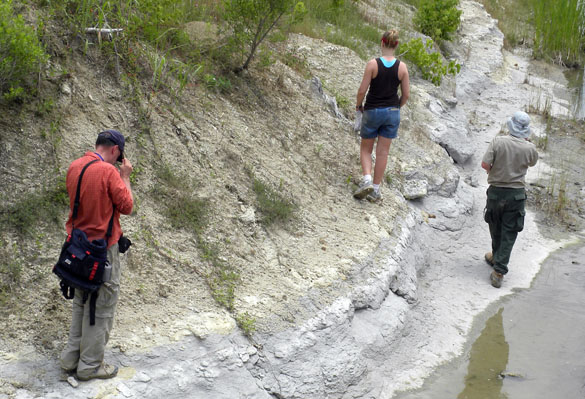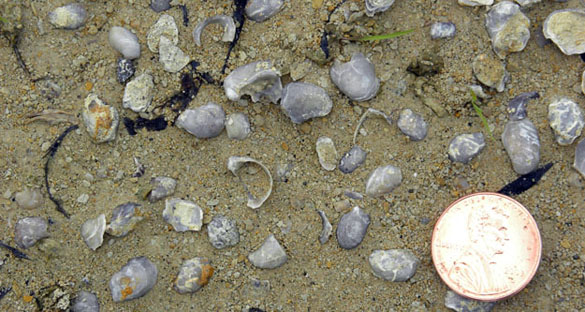 This week’s fossils are by no means rare — last year Megan Innis and I picked up dozens of them at a muddy outcrop near Starkville, Mississippi, on our Cretaceous-Paleogene boundary expedition (click “Alabama” and “Mississippi” in the tags to the right for entries from that trip). They are, though, significant indicators of a particular kind of ecological system that appeared in the oceans of southeastern North America after the cataclysm of the Cretaceous Extinction.
This week’s fossils are by no means rare — last year Megan Innis and I picked up dozens of them at a muddy outcrop near Starkville, Mississippi, on our Cretaceous-Paleogene boundary expedition (click “Alabama” and “Mississippi” in the tags to the right for entries from that trip). They are, though, significant indicators of a particular kind of ecological system that appeared in the oceans of southeastern North America after the cataclysm of the Cretaceous Extinction.
The specimens pictured above are Pycnodonte pulaskiensis, a local species of oyster that belongs to a very prolific genus found around the world. Pycnodonte ranges from the Lower Cretaceous (about 140 million years ago) to, it appears, today. Kase and Hayami (1992) appear to have found this oyster — or a close relative — still living in submarine caves near Japan. This makes them a kind of “living fossil”, a group with a very long history of evolutionary stability.
This longevity fits into our Pycnodonte pulaskiensis story. These fossils are very common in the lowest Paleocene sediments just above the extinction horizon that marks the fiery end of the Cretaceous. After all that devastation (and Alabama was uncomfortably close to the impact site of Chicxulub), P. pulaskiensis appeared first to reoccupy the seafloor muds. They were virtually alone in this muddy habitat, and so lived there in great numbers. We call this kind of early successional species an “opportunist” (in the good sense!) taking advantage of a recently emptied niche.

Paul Taylor, Megan Innis and George Phillips at the Cretaceous-Paleogene boundary near Starkville, Mississippi in May 2010. Our oysters were found directly below Megan's feet.
These little oysters weren’t entirely alone, though. Many of them have small beveled holes in the center of their left valves, producing the ichnofossil Oichnus. These are apparently the traces of naticid gastropod predators (see Dietl, 2003) that drilled the holes to kill and eat the oyster soft parts. (And who can blame them?) Several shells also have encrusting foraminiferans like Bullopora and Ramulina. Small hints of a recovering ecosystem setting the stage for the modern fauna we see in the northern Gulf of Mexico today.
References:
Dietl, G.P., 2003. Traces of naticid predation on the gryphaeid oyster Pycnodonte dissimilaris: Epifaunal drilling of prey in the Paleocene. Historical Biology 16: 13-19.
Kase, T. and Hayami, I., 1992. Unique submarine cave mollusc fauna: composition, origin and adaptation. Journal of Molluscan Studies 58: 446-449.




Yea! My oysters made it to the Fossil of the Week list!